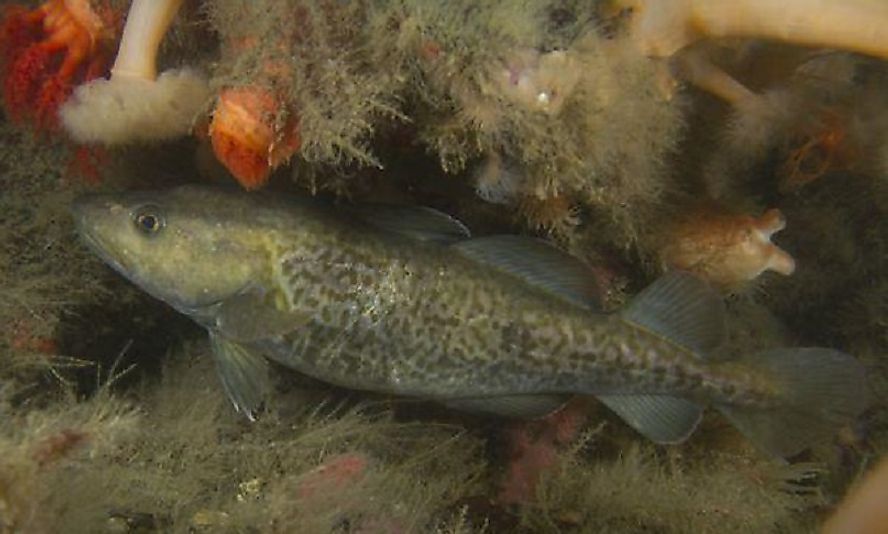Native Fish Species Of Greenland

Greenland is an autonomous self-governing country that is part of the realm of Denmark. The country has been self-governing since 1979. Greenland is the world's largest island and about 75% of the country's land is covered in the only permanent ice sheet on Earth that is found outside of Antarctica. Greenland is located between the Arctic and North Atlantic Oceans, being located close to the Arctic. This article will discuss some of the native fish that can be found in this large, cold and barren landscape.
American Eel
The American Eel, scientifically named Anguilla rostrata, is a species of ray-finned fish that is a member of the Anguillidae family of ray-finned fishes, of which freshwater eels are members. Adults of this species grow to be about 4 feet (1.22 meters) long and weight around 17 pounds (7.5 kilograms). This species has a long and snake-like body, with small scales and eyes. Males are lighter in color and have high fins, but the females of the species are usually larger. This species is catadromouos, meaning that it migrates down from freshwater rivers to the ocean to reproduce. The species is found for most of its life in freshwater lakes, rivers, streams, lagoons, estuaries and other coastal waters. The species is only found in bodies of water that are connected to the sea. This species has an extremely wide range and is found as far north as Greenland all the way down the east coast of Canada and the United States. It is also found in the Caribbean, the Gulf of Mexico, along the east coast of Central America and along the northern coast of South America. According to the International Union for Conservation of Nature (IUCN) Red List the American Eel has been listed as being an endangered species since 2013 and has a decreasing population. This species is facing many major threats, including loss of habitat, dying to the turbines of hydroelectric dams, the bio-accumulation of contaminants in the environment, the Anguillicola crassus parasite, climate change, barriers to migration, and from fisheries.
Atlantic Halibut
The Atlantic Halibut, scientific name Hippoglossus hippoglossus, is a species of flatfish that is a member of the Pleuronectidae family of flounders. This species is one of the largest species of bony fish on Earth and adults of this species grow to be up to 15 feet (4.7 meters) long and weight around 710 pounds (320 kilograms). This species has an upper body that can either be completely chocolate, olive, or slate in color, while its underside is a pale color. This species lives and feeds near the sand, gravel or clay bottom of the ocean at depths that can range between 160 to 6,560 feet (50 to 2,000 meters). This species is found in the northern part of the Atlantic Ocean along the east coast of North America, from as far south as Virginia to as far north as Greenland and Iceland. It is also found west as far as Norway and Russia. According to the IUCN Red List of Threatened Species, the Atlantic Halibut has been listed as being an endangered species since 1996 and its current population trend is unknown. The major threats that the species faces are from over-fishing from fisheries, especially due to the species slow growth rate.
Four-Horned Sculpin
The Four-Horned Sculpin, scientific name Triglopsis quadricornis, is a species of fish that is a member of the Cottidae family, which is the largest family of sculpin fish. Adults of this species rarely grow to be larger than 6 inches (15 centimeters) in lakes, but grow to between 8 and 12 inches (20 to 30 centimeters) in the ocean. This species has a big knobbly head, protruding lips and it is a darker brownish color. The female of the species have a white colored belly, while the belly of males is a yellow-brown color. This species is found in freshwater lakes, freshwater shallow coastal areas, saltwater shallow coastal areas, estuaries and coastal rivers. This species is found in the Baltic Sea and the Arctic Water off of Russia, Sweden, Finland, Norway, Estonia, Latvia, Lithuania, Poland, Germany, America, Canada and Greenland. According to the IUCN Red List of Threatened Species, the Four-Horned Sculpin has been listed as being a species of least concern since 2008 and it has a stable population. These species may face some local level threats, but currently it has not major threats effecting it.
Conservation of the Native Fish of Greenland
There are conservation measures that are being carried out to help these and other native fish of Greenland. There are fish farms that are being invested in for the Atlantic Halibut in many of the countries where it is found so that the species can be grown for food without having to be over-fished in the wild. The government of Greenland, as well as other countries where these species are found, have passed laws to protect these species, establish protected areas and put certain limits of fishing.
Native Fish Species Of Greenland
| Native Fish of Greenland | Scientific Name |
|---|---|
| American Eel | Anguilla rostrata |
| Ekaluk Charr | Salvelinus alpinus alpinus |
| Four-Horned Sculpin | Triglopsis quadricornis |
| Kakilisak (Three-Spine) Stickleback | Gasterosteus aculeatus aculeatus |
| Kapisilik (Atlantic) Salmon | Salmo salar |
| Nine-Spined Stickleback | Pungitius pungitius |
| Sea Lamprey | Petromyzon marinus |
| Capelin | Mallotus villosus |
| Atlantic Halibut | Hippoglossus hippoglossus |
| Greenland "Ogac" Cod | Gadus ogac |







